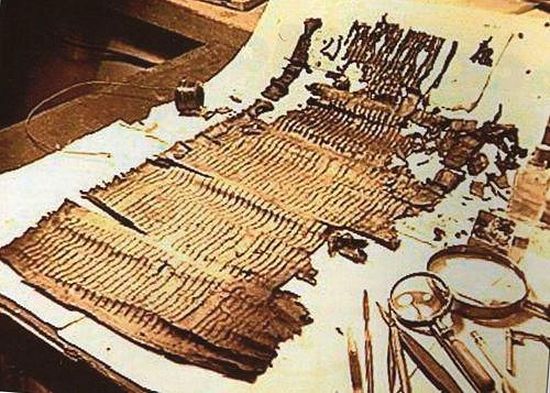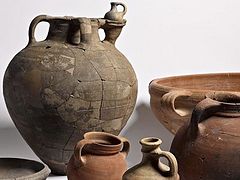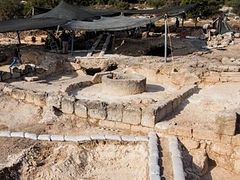Source: Travelujah.com
For the last 45 years a highly fragile mystery resembling a small piece of charcoal or two-day old dog poop has been ensconced in the bowels of the Israel Antiquities Authority here. Carbon 14 dated to c. 600 CE, the 7 cm long charred cylindrical shaped parchment was locked away in the IAA's offices in the sprawling campus of the Israel Museum. Protected by guards and doors with numeric locks, the tiny manuscript lay unread and illegible, defying scientists to discover a way to decipher it.
Excavating the 1,400-year-old Ein Gedi synagogue, archaeologist Dr. Dan Barag found the scroll and dozens more even smaller fragments among the ruins of the Jewish village's Torah ark. It was the first time texts had ever been found in the remains of a Torah ark. But the content of those texts remain tantalizingly out of reach.
Barag died in 2009 with the mystery still unresolved. But Dr. Sefi Porath, his co-excavator at the dig at the oasis on the western shores of the Dead Sea, never gave up hope that scientific advances would one day allow the leather scroll to be read.
Speaking at a press conference Monday at the IAA where the newly-deciphered biblical treasure - now revealing the text of Leviticus 1:1-8 in easy to read Hebrew albeit it with several lacunae - Porath grinned like a giddy teenager. "There was no such thing as a personal computer in 1970 when this scroll was discovered."
Even getting a telephone installed in Israel was no simple matter in those days following the Six-Day War. Every few years Porath would ring up the IAA to see if there were any encouraging developments. In more recent decades he would fire off an e-mail.
"I'm a lucky person. This is one of the peaks of my career," he added.
That's no small statement from the archaeologist who in 1960 discovered the Babatha letters at a nearby site in the Judean Desert known as the Cave of Letters where troops aligned with the rebel leader Bar Kochba hid out. The priceless archive of 35 documents in Hebrew, Greek and Aramaic, tied with twine and placed in a leather pouch, contained the legal history including marriage, property transfers and guardianship of a woman who lived on the eastern side of the Dead Sea 1,900 years ago. The documents discovered by Porath revolutionized scholars' views about the doomed revolt of 132-135 CE.
Last year, responding to one of Porath's nudnik queries, Pnina Shor, curator and director of IAA's Dead Sea Scrolls Projects which includes the IAA's Lunder Family Dead Sea Scrolls Conservation Center which uses state of the art and advanced technologies to preserve and document the Dead Sea scrolls, decided to take a gamble to try to decipher the mystery parchment using a combination of two new promising technologies.
The first involved an offer by Merkel Technologies Company, Ltd., based in Yehud, to voluntarily scan thousands of 2D images of the fire-damaged tiny scroll. Utilizing its microcomputed tomography machine (micro-CT), Merkel created a high resolution 3D image.
This in turn was sent to the University of Kentucky where a computer science team headed by Prof. Brent Seales was able to complete the virtual unrolling of the scroll last week using proprietary digital imaging software which allowed for the visualization of the unseen text. That software was developed with funding from the U.S. National Science Foundation.
This is "just like what they do in the doctor's office but at a very high resolution, probably a hundred times more accurate than the medical procedures that we do," Seales explained.
Adding to the extraordinary atmosphere of high tech, hard work and international co-operation, Seales said in a Skype conversation broadcast at the IAA offices at the Israel Museum in Jerusalem that he doesn't read Hebrew. "I've never seen the scroll. And that's indicative of our digital age," the chair of the Department of Computer Science at the university in Lexington, Kentucky noted. In the background were some of the eight students who worked with him at his pioneering lab in the tedious and exacting process of making the burnt scroll's text legible. Seales beamed "We've all been celebrating here."
He was not the only one reveling.
"After the Dead Sea Scrolls, this has been the most significant find of an ancient Bible," said Shor, referring to hundreds of ancient texts found in the late 1940s near the shores of the inland sea for whom the scrolls were named.
Until the virtual unrolling of the Ein Gedi fragment of Leviticus, there had been a millennium long gap between the 2,000-year-old Dead Sea Scrolls dating from the late Second Temple Period and the medieval Aleppo Codex written in the 10th century C.E. Now scholars have a point of reference in the middle centuries.
While only eight verses of Leviticus were decoded by Seales' team, that text - which details animal sacrifices brought to the Tabernacle - confirms the Masoretic text of the Torah, according to Shor. In other words, the discovery at the Ein Gedi synagogue suggests the Torah has been faithfully preserved over the millennia, and that copyists mistakes have not crept in.
"Dealing with the Dead Sea Scrolls on a daily basis is really a privilege. The knowledge that we are preserving the most important find of the 20th century and one of the Western world's most important cultural treasures causes us to proceed with the utmost care and caution and use the most advanced technologies available today. This discovery absolutely astonished us: we were certain it was just a shot in the dark but decided to try and scan the burnt scroll anyway. Now, not only can we bequeath the Dead Sea Scrolls to future generations, but also a part of the Bible from a Holy Ark of a 1,500-year old synagogue!"
What of the future?
Shor noted that 3D images made by Merkel's Micro-CT scanner of ancient phylactery (tefillin) cases discovered at the Dead Sea have also been sent to the University of Kentucky. The IAA is breathlessly waiting to discover if the texts placed 2,000 years ago inside those leather boxes are the same biblical passages which Orthodox Jews today wrap around their arm and head on weekday mornings.
The great surprise and excitement set off when the first eight verses of Leviticus suddenly became legible may be the harbinger of even greater discovers.
The text
The newly deciphered scroll, containing the first eight verses of the book of Leviticus in Hebrew, reads as follows:
"The Lord summoned Moses and spoke to him from the tent of meeting, saying: Speak to the people of Israel and say to them: When any of you bring an offering of livestock to the Lord, you shall bring your offering from the herd or from the flock. If the offering is a burnt offering from the herd, you shall offer a male without blemish; you shall bring it to the entrance of the tent of meeting, for acceptance in your behalf before the Lord. You shall lay your hand on the head of the burnt offering, and it shall be acceptable in your behalf as atonement for you. The bull shall be slaughtered before the Lord; and Aaron's sons the priests shall offer the blood, dashing the blood against all sides of the altar that is at the entrance of the tent of meeting. The burnt offering shall be flayed and cut up into its parts. The sons of the priest Aaron shall put fire on the altar and arrange wood on the fire. Aaron's sons the priests shall arrange the parts, with the head and the suet, on the wood that is on the fire on the altar." (Leviticus 1:1-8).
* * * *
Gil Zohar is an Israeli tour guide as well as a professional journalist and he lives in Jerusalem. He is a frequent contributor to Travelujah-Holy Land Tours. Gil can be reached at GilZohar@rogers.com .




